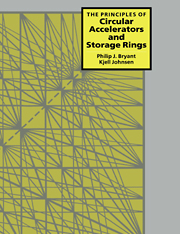Book contents
- Frontmatter
- Contents
- Foreword
- Coordinate system
- Symbols
- Useful Constants
- 1 Introduction
- 2 Basic concepts and constant-gradient focusing
- 3 Alternating-gradient focusing
- 4 Parameterisation of the transverse motion
- 5 Imperfections and resonances
- 6 Chromaticity
- 7 Longitudinal beam dynamics
- 8 Image and space-charge forces (transverse)
- 9 Coherent instabilities
- 10 Radiating particles
- 11 Diagnosis and compensation
- 12 Special aspects of circular colliders
- Appendix A Transverse particle motion in an accelerator
- Appendix B Accelerator magnets
- Appendix C Closed orbits
- Appendix D Phase equation
- Appendix E Vlasov equation
- References
- Index
Appendix E - Vlasov equation
Published online by Cambridge University Press: 11 November 2009
- Frontmatter
- Contents
- Foreword
- Coordinate system
- Symbols
- Useful Constants
- 1 Introduction
- 2 Basic concepts and constant-gradient focusing
- 3 Alternating-gradient focusing
- 4 Parameterisation of the transverse motion
- 5 Imperfections and resonances
- 6 Chromaticity
- 7 Longitudinal beam dynamics
- 8 Image and space-charge forces (transverse)
- 9 Coherent instabilities
- 10 Radiating particles
- 11 Diagnosis and compensation
- 12 Special aspects of circular colliders
- Appendix A Transverse particle motion in an accelerator
- Appendix B Accelerator magnets
- Appendix C Closed orbits
- Appendix D Phase equation
- Appendix E Vlasov equation
- References
- Index
Summary
The Vlasov equation is a powerful tool for finding a self-consistent solution for the behaviour of an assembly of many particles (1010–1020), in which each particle feels the sum of the external forces and the collective force of all particles. The collective forces should not be affected by the interactions between neighbouring particles, which is often expressed as: collisions can be neglected. The equation is an expression of Liouville's Theorem, which states that phase space is conserved along a dynamical trajectory when only Hamiltonian forces are acting, and a simple, but non-rigorous, derivation will be based on this. As with the Hamiltonian formalism described in Appendix A, the Vlasov equation provides a standard approach to problems and ensures the physics is sound leaving only mathematical difficulties.
First, however, it is interesting to make a small digression to discuss phase-space area and phase-space density. In Appendix A and elsewhere care has been taken to use the former term in order to imply a sort of continuous incompressible fluid flowing through phase space. In contrast to this, a beam is an assembly of discrete particles embedded in phase space. Under the conditions specified for the Vlasov equation the forces cannot manoeuvre single particles, so the particle distribution moves as phase space moves. In a given element of phase space there will be a certain density of particles and since the area is conserved so also is the phase-space density (of the particles).
- Type
- Chapter
- Information
- The Principles of Circular Accelerators and Storage Rings , pp. 335 - 336Publisher: Cambridge University PressPrint publication year: 1993



